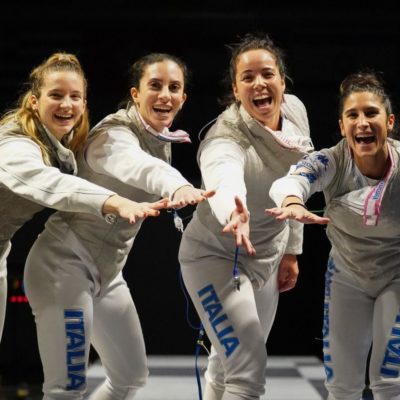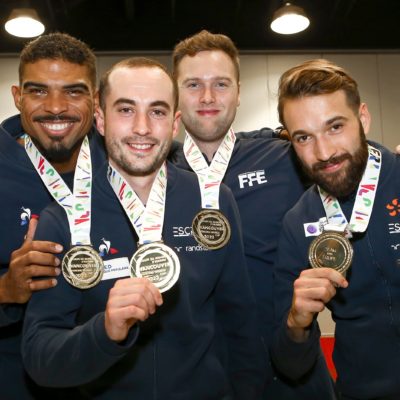The difficulty of teaching preparations is that they involve compound footwork and a complex combination of technique and tactics. By technique I mean the correct execution of a series of physical actions, for example a balestra which lands balanced or an advance-lunge which flows smoothly and accelerates. By tactics I mean a series of actions which, interacting with the opponent, bring about the ultimate in fencing, namely a one-tempo situation.
One-tempo situation: a time when all relevant conditions indicate that you can hit your opponent with a simple (one-tempo) action, before he can successfully evade, defend, or counterattack.
Footwork can be broken down into three categories: maneuvering (setting a pattern or feeling out the opponent’s rhythm), closing (actively attempting to reach one-tempo distance), and finishing (lunge or fleche once in one-tempo distance). The discussion of compound footwork here refers to closing and/or finishing footwork. Initially we teach beginners to jump, then lunge. Advance, then lunge. Jump, then advance, then lunge. Nearly all beginners have the problem that if you tell them to jump-lunge, they will start the lunge before they finish the jump and end up with a mess of feet going random places. Beginners must learn simple footwork motions separately at first in order to get them right.
Advanced beginners are taught to do advance-lunge, jump-lunge, and so forth as units (compound units, but still single “chunked” actions). This is both good and bad. Clearly they must be taught to do a smooth advance-lunge or jump-lunge, because if they do the first part as a preparation and get to the right distance, then pause before they lunge, the opportunity is missed. However, if they always treat an advance-lunge or a jump-lunge as a unit action to be conceived of in advance, they will end up in a situation where they decide that they’re at perfect advance-lunge distance, they do a perfect advance-lunge, but the opponent takes an extra retreat so they lunge into empty space.
The answer to this problem is that except for maneuvering footwork, a piece of compound footwork is solely a technical exercise with no tactical nature. If I do a jump as a preparation (possibly with some blade action to invite a response, though the line problem is subsidiary), I do not know in advance what my opponent’s reaction is going to be. If they crush distance, I may have to retreat. If they don’t retreat in time, I can lunge and hit. If they retreat in time, I must make a further preparation and the problem continues. Thus I must not conceive in advance of doing a jump-lunge, for example, because the result of the jump may not make the lunge appropriate. But if I jump, then pause to see what the opponent does, then almost by definition their retreat will be in time and an opportunity is lost. So I make the decision of what’s to come after a simple unit of preparation while the preparation is still in progress. If they don’t retreat in time, the jump becomes the first half of a smoothly connected jump-lunge. From the outside it looks like I planned to do a jump-lunge from the outset, but in fact only the developing situation turned that jump into a jump-lunge. This develops further as the distance problem stretches into longer and longer combinations of footwork. It may be that I manipulate the distance continuously over a series of several pieces of footwork, stealing an eighth of an inch here, a tenth of a second there, until finally I’ve broken the distance and I get to hit. From the outside it all flows smoothly together without pause, but nobody should believe that I intended from the very start to do a retreat-jump-advance-fastadvance-longretreat-halfretreat-advance-lunge in order to hit my opponent.
To sum up in a suitably Zen fashion, from a technical standpoint, footwork actions should flow together into a continuous stream without pause, demarcation, or imbalance (unless a pause is itself used as an element to break tempo). But from a tactical and intentional standpoint, each footwork motion stands independent of all others, with no knowledge of what came before or what is yet to come. What is yet to come only becomes apparent while the current action is progressing.
Copyright © 1998 by Gregory A. Jones
This article may be reproduced freely, as long as it remains unmodified and his copyright notice is included.





